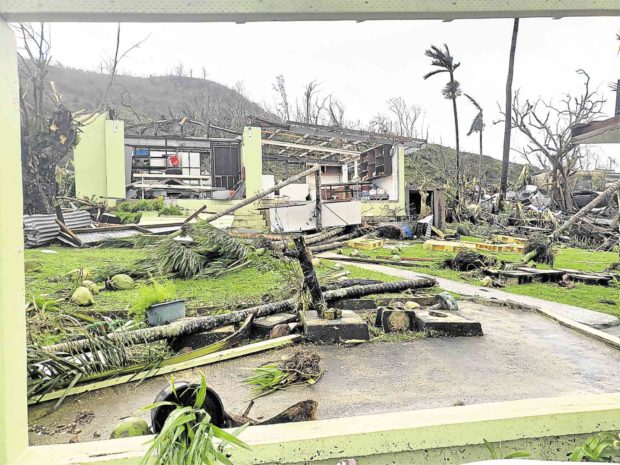
DESTRUCTION IN SAIPAN Supertyphoon “Yutu,” packing winds of nearly 300 kilometers per hour, ripped off roofs, overturned cars and toppled trees on the island of Saipan in the Northern Marianas. The strongest storm to hit US territory is expected to slam Cagayan Valley on Tuesday. —AP
Supertyphoon “Rosita” (international name: Yutu), a Category 5 “Yolanda-like” storm that ravaged Northern Marianas on Thursday, is expected to make its strength felt in most of Luzon on Monday ahead of its landfall.
One of the world’s strongest tropical cyclones, Supertyphoon “Yolanda” (international name: Haiyan) barreled through the Visayas on Nov. 8, 2013, killing thousands.
Yutu, which packed maximum sustained winds of close to 300 kilometers per hour when it struck Northern Marianas, is forecast to make landfall on Tuesday in Isabela and Cagayan provinces.
Starting Monday, weather forecasters said Rosita’s moderate to heavy rains were likely to cause floods and landslides in northern and central luzon.
Strong to very strong winds are also expected to affect the eastern section of northern and central Luzon.
Storm Signal No. 1 may be hoisted in Metro Manila by Monday night, according to the Philippine Atmospheric, Geophysical and Astronomical Services Administration (Pagasa).
Strongest this year
Yutu was the strongest to hit any part of the United States this year.
The supertyphoon ripped off roofs, overturned cars, toppled trees and killed a woman who took shelter in an abandoned building that collapsed.
Others were injured, including three people who needed surgery.
Yutu packed maximum sustained winds of 290 kph as it passed over the islands of Tinian and Saipan, according to the US National Weather Service.
By Saturday, power was still out across Saipan, with 50,000 residents, and Tinian, with 3,000 people.
Presidential spokesperson Salvador Panelo assured the public that government agencies were well-prepared and well-coordinated to ensure the minimum loss of lives and destruction from Rosita.
Landslide in Itogon
As Rosita approached northeastern Luzon, geologists warned that widespread rain and winds could trigger another landslide in the mining town of Itogon, Benguet province, and urged the local government to keep people away from danger zones.
“Try to imagine the landslides as open wounds. They’re called landslide escarpments and the possibility remains high these areas would collapse some more if a new storm as strong as [Typhoon] ‘Ompong’ comes our way,” Fay Apil, Cordillera director of the Mines and Geosciences Bureau, said on Sunday.
Ompong brought rains and winds that killed 116 people in the Cordillera, and displaced 74 families in Benguet and Apayao provinces. Most of the fatalities were buried by landslides along illegal mining tenements in Itogon.
Same track as Ompong’s
The government has forcibly relocated families living near landslide-prone areas, which have been designated as danger zones, Apil said.
The weather bureau said Rosita would take the same track as Ompong’s.
As of 3 p.m. on Sunday, Rosita was spotted 760 km east of Aparri, Cagayan, with maximum winds of 200 kph and gusts of up to 245 kph moving west at 20 kph.
Pagasa advised residents in the coastal areas of Isabela and Cagayan to brace for a storm surge.
Residents near low-lying coastal communities are advised to stay away from the coast or beach, cancel all marine activities, and proceed to higher ground or designated safe evacuation areas.
Pagasa advised fishing boats and other small vessels to stay away from the sea with travel risky over the seaboards of northern and central Luzon as well as the eastern seaboards of the Visayas and Mindanao.
Strong to gale-force winds are expected on the seaboards of northern and central Luzon particularly in the provinces of Batanes, Calayan, Babuyan, Cagayan, Ilocos Norte, Isabela, Ilocos Sur, La Union, Pangasinan, Aurora, Zambales and Bataan, where sea conditions will be rough to very rough with waves as high as 2.6 to 5.5 meters.
In Pangasinan province, gale warnings prompted the Alaminos City tourism office on Sunday to stop small boats from sailing to the Hundred Islands National Park. The park was closed to tourists at 3 p.m. on Sunday. —With reports from Julie M. Aurelio, Vincent Cabreza, Gabriel Cardinoza and AP